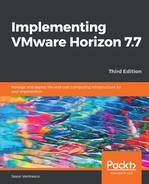The UEM management console User Environment tab can be used to customize user profile settings. UEM offers several different built-in options for managing the profile, as shown in the following screenshot, although, given that it includes the ability to update the registry virtually, any Windows option can be configured, assuming you know the proper syntax:

Most of the settings are self-explanatory for anyone with basic Windows knowledge. These include Drive Mappings, Environment Variables, File Type Associations, Logon Tasks, Logoff Tasks, Printer Mappings, Registry Settings, Shortcuts, and common Windows Settings. Each of these represents items you can customize using traditional Windows GPOs, but the advantage of using UEM is that you don't need permissions in AD to configure these settings. The following remaining items can be set using the User Environment tab:
- ADMX-based settings: Using the Manage Templates button in the UEM management console, you can import AD ADMX files and use them to implement virtually any GPO setting using UEM.
- Application Blocking: Authorize or block applications within the desktop using detailed conditional policies, without the need to use an overhead of Windows group policies.
- Files and Folders: Copy files or folders to the UEM client, including items such as internet shortcuts.
- Horizon Policies: Apply common policies to Horizon desktops, including PCoIP bandwidth policies, USB redirection, and so on. When combined with the policy Condition tab, this enables very granular control over Horizon settings, without the need to use an overhead of Windows group policies.
- Triggered Tasks: Used to perform different tasks, including custom commands, when a UEM client computer is locked, unlocked, disconnected from, or reconnected to. You can also apply UEM Condition Sets to further control when these tasks are performed.
As stated previously, in many cases the actions these settings perform are something you can do using GPOs or even custom scripts, but the power of UEM is that it is all done from a central console, without the need to make changes to the AD domain itself. Additionally, given the power of features such as UEM condition sets, you can exercise complete control over how and when a given configuration item is applied.
